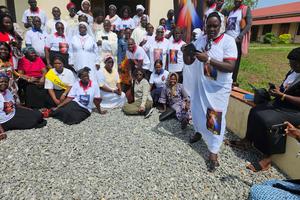Pope Francis to Visit Baltic Nations in September
According to the March 9 communique, the Holy Father will travel to the three nations from Sept. 22-25, visiting the cities of Vilnius and Kaunas in Lithuania, Riga and Aglona in Latvia and Tallinn in Estonia

VATICAN CITY — The Vatican announced Friday that Pope Francis will visit Estonia, Latvia and Lithuania in September, confirming speculation of a papal visit to the Baltic Sea countries that have been circulating for months.
According to the March 9 communique, the Pope will travel to the three nations from Sept. 22-25, visiting the cities of Vilnius and Kaunas in Lithuania, Riga and Aglona in Latvia and Tallinn in Estonia.
The logo and motto for the visits were released along with the dates of the trip. Currently there is no official program for the visit, however, it is expected to be published shortly. Francis' September visit marks the first papal trip to the countries in a quarter of a century. He will be the second pope to travel to the Baltic states, exactly 25 years after St. Pope John Paul II, who visited the three countries in September 1993.
The theme for his visit to Lithuania is “Christ Jesus — Our Hope.” The motto for his visit to Lativia is “Show Thyself a Mother” in honor of the Virgin Mary, and the theme for Estonia is “Wake Up, My Heart!”
Each of the countries is predominantly Christian, with a mix of Catholic, Protestant and Orthodox populations, meaning that Francis' visit, in keeping with his style, will likely have a strong ecumenical focus.
Both Estonia and Latvia have large Lutheran and Orthodox populations. Lithuania, on the other hand, is overwhelmingly Catholic, influenced largely by its historical connection to Poland.
More than 75% of the nearly 3 million people in Lithuania are Catholic, while Orthodox Christians make up about 4% of the population.
Latvia and Estonia, though historically Lutheran, have become increasingly nonreligious. In Latvia, Lutheranism still accounts for about 34% of the population of just under 2 million and Catholics make up 25%, primarily in the eastern portion of the country. The third largest church in the nation is the Latvian Orthodox Church.
In Estonia, around 54% of the population of 1.3 million identify as non-religious. The Eastern Orthodox Church accounts for about 16% and Lutheranism for almost 10%.
The Holy Father’s visit also holds historical significance for the three countries, as the trip will take place during the centenary year of their establishment as independent states.
Until 1917, Estonia, Latvia and Lithuania formed part of the Russian empire. They gained independence in 1918, and remained independent until 1940, when they became part of the Soviet Union and endured Nazi domination from 1940-1944.
After their years under Nazi control, they were returned to the Soviet Union in 1945, and regained democratic independence in 1991. They have been members of the European Union since 2004.
St. John Paul II had a special fondness for Lithuania in particular, and shortly after his election famously declared that “half of my heart is in Lithuania.”
The Lithuanian capital of Vilnius is also linked to the image of Divine Mercy, as it was the city in which St. Faustina Kowalska received the visions of Jesus requesting the painting of the Divine Mercy image, and is where the original Divine Mercy image is located, to which John Paul II had a special devotion.
- Keywords:
- divine mercy
- estonia
- latvia
- lithuania
- pope francis

















